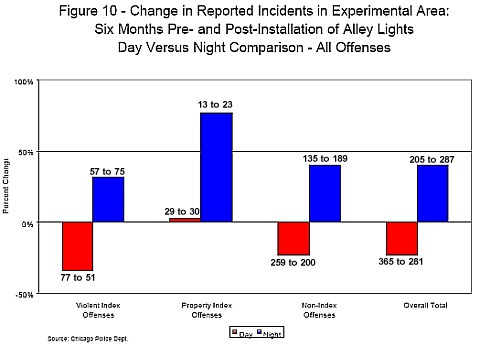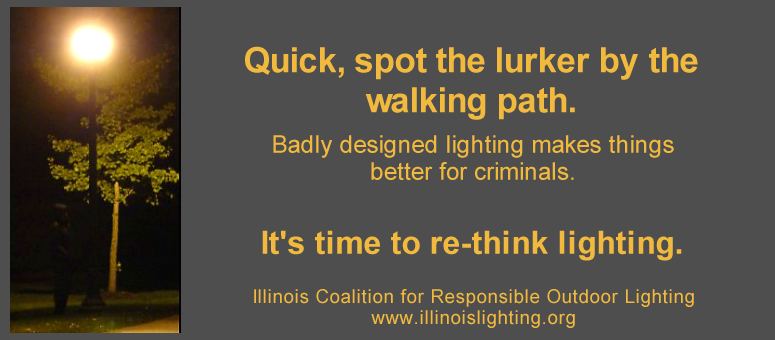Working toward legislation to curb light pollution in Illinois.
|
Having our residences invaded by burglars is a concern for us all. In 2008, over one and a half million residences in the United States were burglarized1. To keep our homes from being added to the lists of those victimized, we need to look at the factors that make a home a target, and others that make a home uninviting to the criminal. 
Of all those residential burglaries in 2008 where a time of day is known for the crime (usually, as opposed to crimes which were committed during an extended absence of the residents,) 65% were committed during the daylight hours1. If about two-thirds of the burglaries occurred during the half of the day when the sun is up, what does this say about the effect of the presence or absence of light on the likelihood of a burglary occurring? Statistically, the answer is clear: Darkness is not a leading causal factor for residential burglaries; if anything, it somehow reduces the likelihood of their occurrence. 
What about in other locations -- does added light at night make us safer? The answers are harder to draw out of the statistics, when we look at all the other environments we are concerned about away from our homes. It seems evident, in general, that lighting which is carefully prescribed to fill a demonstrable need in a specific situation can have positive effects in crime prevention. But that does not make the prescription of added light any more effective in a general blanket installation than the use of prescription medicines is against the wrong diseases. The evidence of effectiveness in one set of circumstances does not necessarily transfer to all others, as many people assume it does -- penicillin and other anti-bacterials may cure some infections well, but many doctors find themselves repeatedly trying to explain to their patients that those antibiotics will do nothing to combat influenza, or the common cold. 
In some instances, added lighting has proved to be an encouragement for crime, rather than a deterrent. Also referred to on this website's Key Issues > Light, Safety & Crime page is how some school districts in different parts of the U.S. have discovered that when the "security" lights installed around some of their schools were turned off because of budgetary problems, the vandalism at those locations decreased, rather than increasing as had been expected4. Not only do criminals of any sort need light to see what they are doing (just like any of us doing any activity at night,) prominent illumination can make a house, school or business stand out, and give the impression that there is likely to be something at that location worth stealing or vandalizing. And it is easily demonstrated that, in any situation, poorly applied lighting reduces both safety and security. Glare inhibits the neighbor or law enforcement officer from seeing the activity on a property; it also is often teamed with areas of deep shadow, where anything could be going on. Well-applied illumination at night can serve as a medicine in the combat against some forms of crime in some locations. But in a sustainable world, such lighting will need to be applied by carefully administered prescription, recognizing that, just as in medicine, improper application does no good -- and may actually cause harm. Also as in medicine, the drugs -- in this case the lighting fixtures -- need to be analyzed for effectiveness before they are marketed as "cures." The uncontrolled dumping of lighting into our world is reminiscent of the era of patent cure-all "medicines"; our fears are being played on to sell vast amounts of lighting products (and costly power,) much of it with little or no benefit and possibly bringing harm instead. 1FBI 2008 Crime in the United States report, Table 7. 2The Washington State Crime Prevention Association's manual for homeowners entitled "What to do Before the Burglar Comes" lists a number of factors which make a home a prime target for burglars, and recommends preventative actions; note that nowhere do they "blame the darkness", or advise a blanket of exterior lighting as an effective preventative. 3Chicago Alley Lighting Project - Final Evaluation Report (2000). 4A report from Peninsula School District, Gig Harbor, Wa. For more discussion of these topics, see our Key Issues > Light, Safety & Crime page, and the Light, Safety & Crime section of our Resources > Links page. 
|
Return to Page TopThis page available as an Adobe Acrobat document Here |
|||
light pollution Illinois Chicago Cook County DuPage County Will County Springfield energy enviromnent global warming anti light pollution legislation lighting ordinances |
|||

